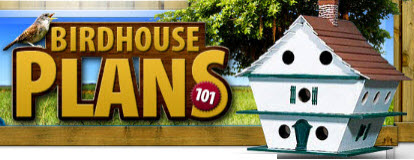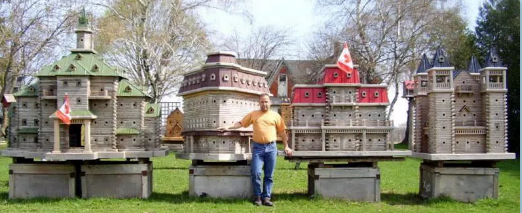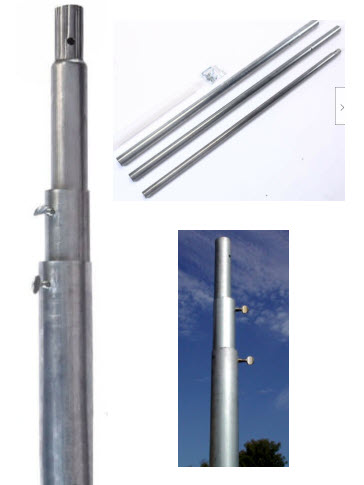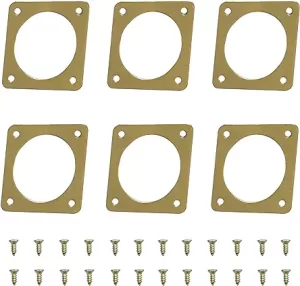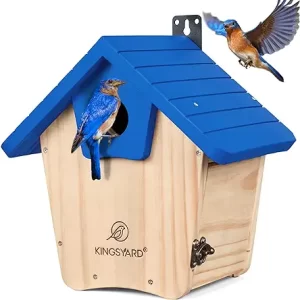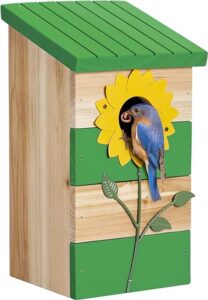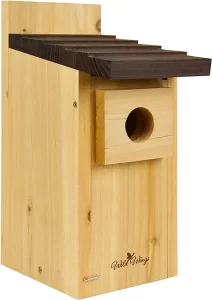Uncategorized
finch bird houses
Super simple and house finch favorite birdhouse
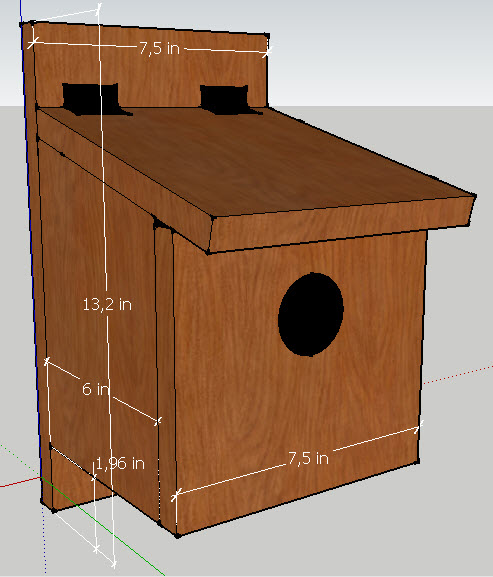
Cutting list:
1.Back wall 7,5″ x 13,2″
2.Both sides are the same. 8,5″ x 6″
3.Floor 6″ x 6″
4.Roof 7,5″ x 8,5″
Good calculation formula on how to choose the right screws.
You can get the right screw diameter by dividing the material thickness by 4 (0,75″ : 4 = 0,18″), and the right length by multiplying the material thickness by 2.25 (0,75″ x 2.25 = 1,68″)
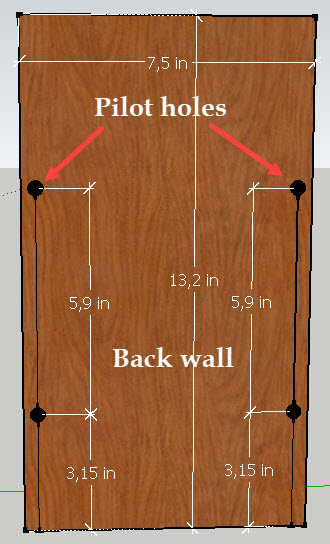
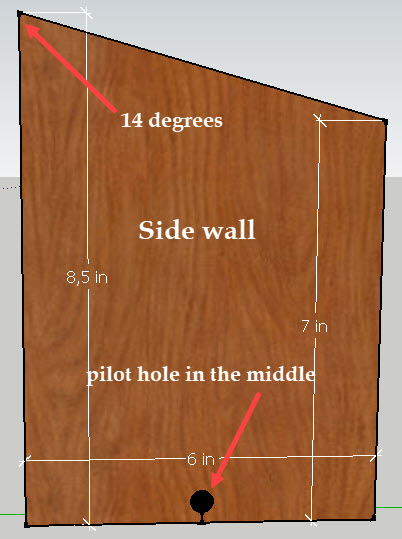
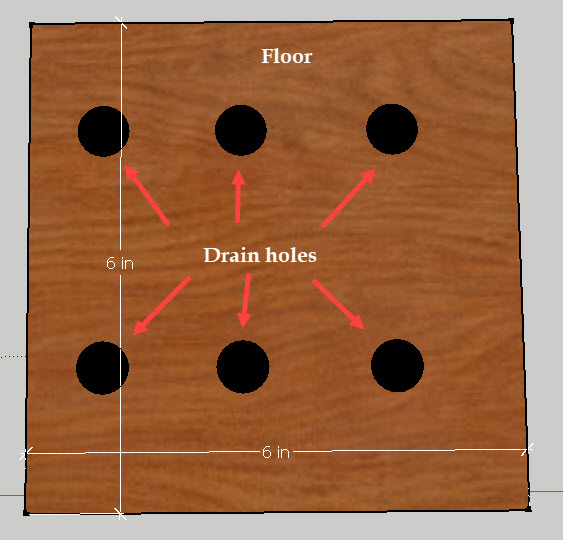

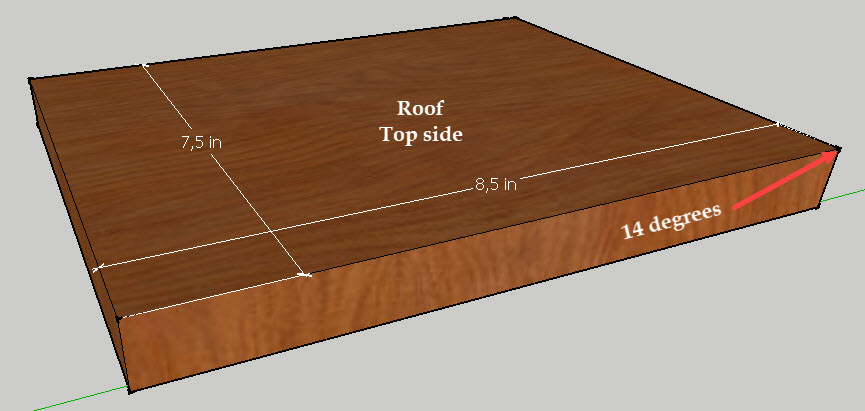
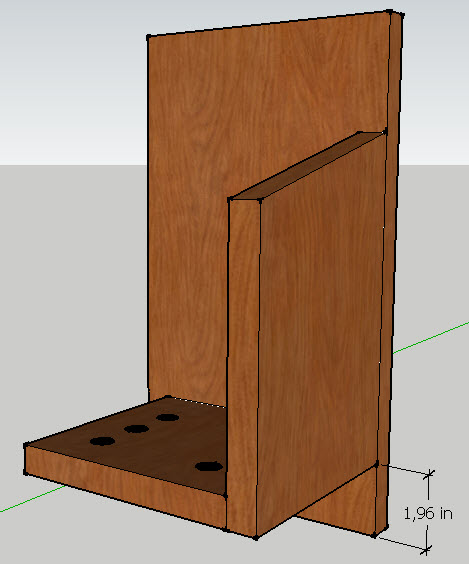
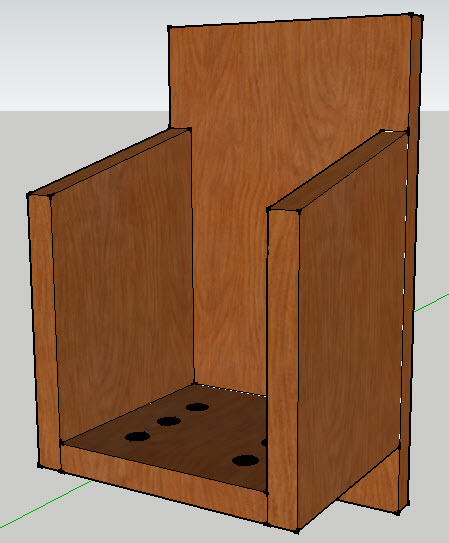
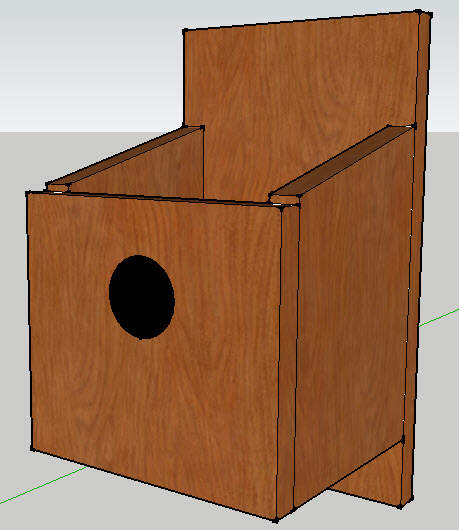

birdhouse plan
Free Bird house plans. You can build today
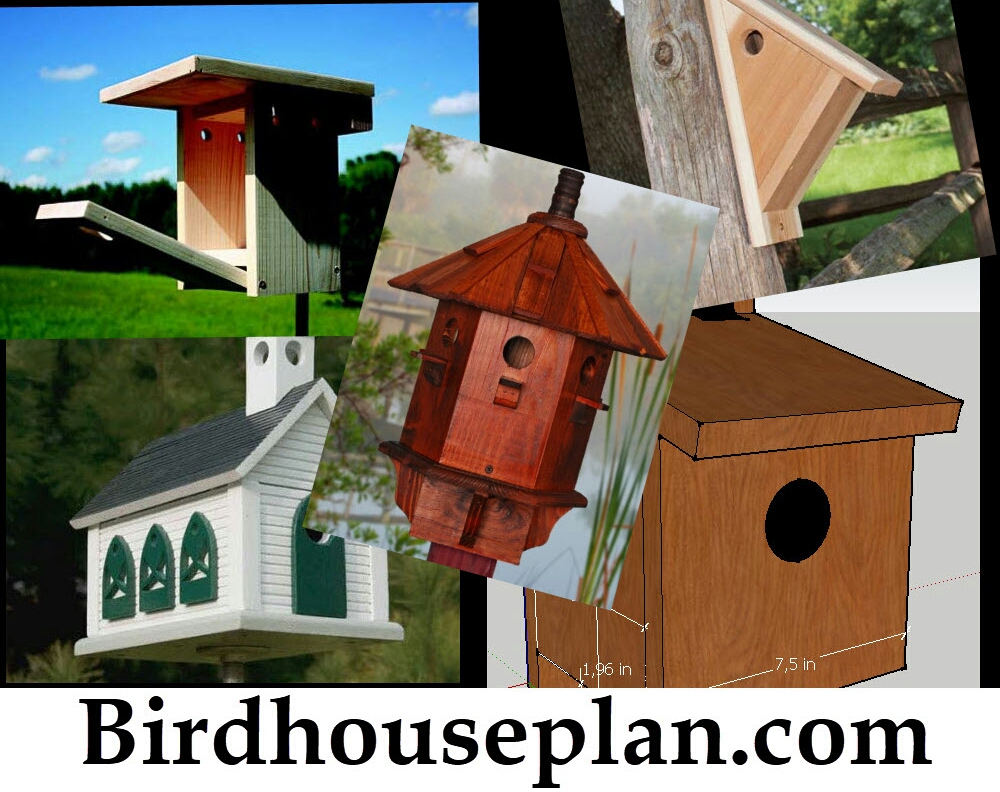
Looking for cozy free bird house plans for your feathered friends? Here are big list of free Bird house plans that comes with complete measurements, instructions, pictures, tools and material lists.
Building a birdhouse plan is an excellent project for those looking to get started with woodworking, as it offers just the right amount of difficulty. However, it’s important to keep in mind that you’re building a home for a bird. So it’s crucial to choose the perfect free birdhouse plan that’s suitable for the bird species you want to attract. We made a research for you and select a plans that meets the needs of cavity nesting birds.
Before you choose a free Bird house plans, keep this in mind
You need to know which bird species you are building a birdhouse. Because, for example, a robin’s birdhouse is not suitable for a bluebirds and vice versa. Each bird species has its own needs and nesting habits.
First: Observe which bird species live in your area, then you know which free bird house plan to choose. But if you don’t recognize bird species, here are two good books with which you can determine what bird species live in your neighborhood.
There are 75 different birdsongs in this book. Listen for a moment, what sounds do you hear in your yard?
Second: You need to know where to install the birdhouse. For example, a bluebird likes a birdhouse 4 to 6 feet off the ground, in a spacious area, but not too far from trees.
Third: Choose your favorite free birdhouse plan from this list and start building.
Learn where to place your birdhouse.
Right entrance hole is important(entrance hole chart)
What wood is best when building a birdhouse
Attract your favorite birds with right food in your birdhouse or feeder
Free bird house plans
Choose your favorite and build a stylish and functional birdhouse that will provide a safe haven for your local birds.
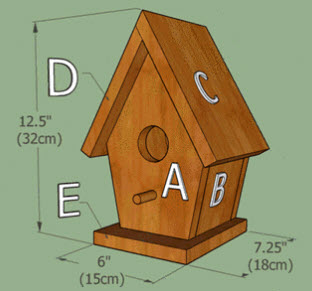 DIY, Homemade Bird house plan
DIY, Homemade Bird house plan
With this first option, you can use it to attract nuthatches, chickadees, bluebirds, wrens, woodpeckers, warblers, and sparrows, among other birds to your garden or backyard.
The best part about this free birdhouse plan is that it’s easy to build from scratch and come up with a functional and good-looking birdhouse.
We highly recommend using this type of mounting post. That’s why, if you want to attract bluebirds, their birdhouse must be firmly in place and not sway. This post is great for that. However, if you want to attract a wren or a chickadee, you can hang it on a tree branch or under the eaves. It doesn’t bother them if the birdhouse sway.
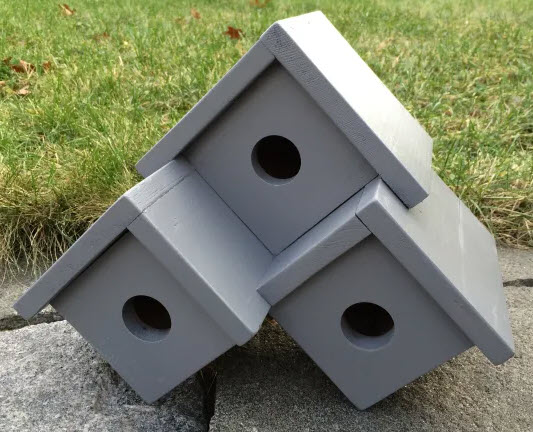 The Three-Unit Condo Bird house plans
The Three-Unit Condo Bird house plans
The three-unit condo birdhouse plan is an interesting combination of three small-wooden birdhouses. All three birdhouses are built separately and finally attached to form the three-unit condo.
According to these measurements, this DIY free bird house plan complex is designed for swallows and purple martins. Place the birdhouse 12 to 20 feet (3 to 6m) off the ground in a very open area.
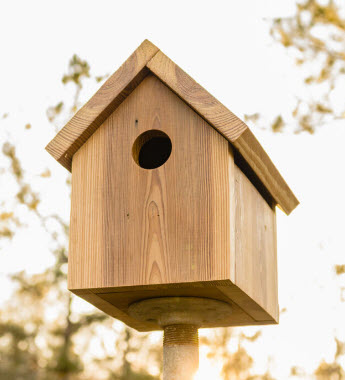 Simple DIY Bluebird Birdhouse plan
Simple DIY Bluebird Birdhouse plan
As you may know, bluebirds are very specific about the kind of habitats they live in. So, this free bird house plan can be a perfect attraction for the bluebirds in your garden or backyard. More bluebird plans here.
But if building a birdhouse is too complicated for you, don’t worry.
Then here are the best bluebird house kits.
Related: With these 3 simple tricks, the house sparrows did not occupy the blue bird house.
 Scrap Wood Birdhouse
Scrap Wood Birdhouse
Scrap wood birdhouse plan. Most people undervalue scrap wood for what it’s worth but this material can produce impressive, and functional birdhouse designs for those birds in your backyard.
Build a birdhouse to sell. Evaluate your work correctly as a businessman. Here is the best book on “How to price crafts”
Easy $2 Birdhouse plan
Surprised? Well, you shouldn’t be, because not all birdhouses need to be expensive to accommodate those cute buddies. These DIY Bird house plans doesn’t need a budget of more than $2 to come up with a perfect home for the birds.
You can set up a birdhouse builder business. Similar birdhouses cost over $ 40. Is it still the right price? Evaluate your work and product correctly with this book, “Woodprofits”.
Related: Where To Place a Birdhouse
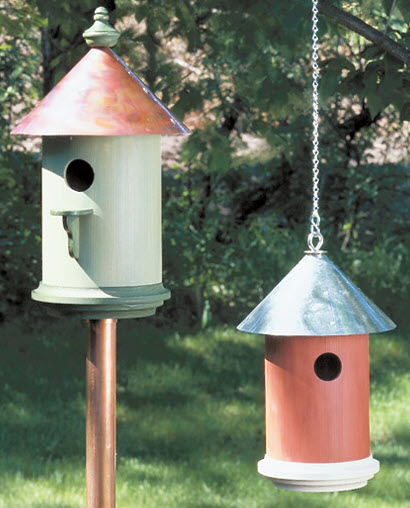 Round, Coopered Birdhouse
Round, Coopered Birdhouse
If you are looking for a birdhouses that cuts all the corners, then this round, coopered bird house design can deliver exactly that for a beautiful home for the birds.
 A Simple PVC Birdhouse
A Simple PVC Birdhouse
This design takes a different approach with the materials used but still works perfectly and at an affordable budget. Studies show that sparrows do not like PVC bird houses. Which is great for blue birds where they can raise their chicks in peace.
Sparrow resistant bluebird house
 Two-Room Log Cabin Birdhouse
Two-Room Log Cabin Birdhouse
Using log cabins, this DIY bird house plan makes it easy for you to come up with a cozy home for the birds that need a habitat.
Related: The wrong seeds can get stuck in the bird’s throat. Here is a guide to which seeds are right
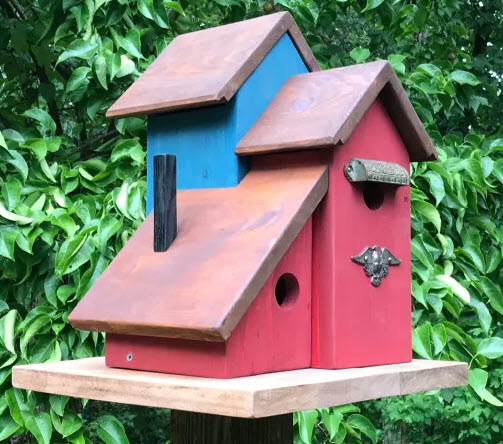 Multi-Unit Condo Bird house plan
Multi-Unit Condo Bird house plan
Nothing says home to the birds like a multi-condo birdhouse with ample space for all the birds. And this is what you can achieve with this DIY birdhouse project.
 A Simple Dovecote Style Birdhouse
A Simple Dovecote Style Birdhouse
Thinking of going stylish with a minimal birdhouse design? This simple dovecote bird house is just the thing you need to achieve that desire.
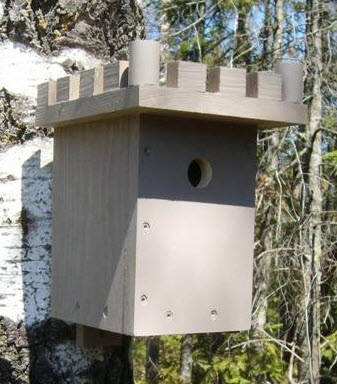 Castle Bird house plan
Castle Bird house plan
Using the right materials, plans, and equipment – you can come up with this minimal, stylish, and functional castle home for the birds in your garden or backyard.
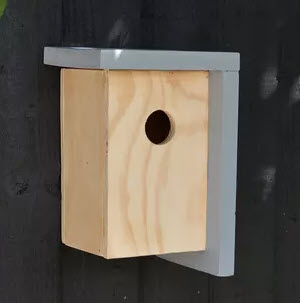 Modern Design Birdhouse
Modern Design Birdhouse
DIY Bird house plans evolve with time and trend, and this one is a modern design birdhouse. It’s easy to create and will only take you a few minutes.
 Kid-Friendly DIY Wooden Birdhouse
Kid-Friendly DIY Wooden Birdhouse
If your child loves birds and wouldn’t mind creating birdhouses for them, this DIY project allows you to coach them as they build a lovely home for those birds in your backyard.
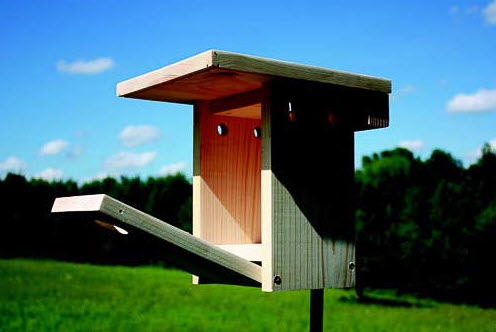 DIY Bluebird Nesting Box
DIY Bluebird Nesting Box
Bluebirds are a charm and what better way to attract them than to create a favorable birdhouse for them. This DIY Bird house design is a true attraction and functional habitat for the birds.
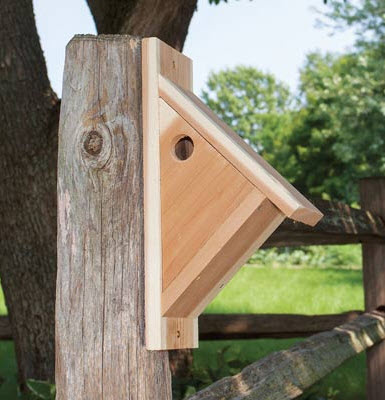 Chickadee Nesting Box
Chickadee Nesting Box
Specifically designed for the chickadee, this bird house plan is both easy to make and can come in handy for the chickadee in your backyard.
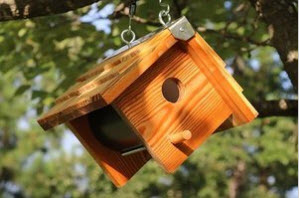 Wooden Bird Box
Wooden Bird Box
The wooden bird box is another easy-to-create DIY bird house plan that can offer accommodation to any type of bird in your garden or backyard.
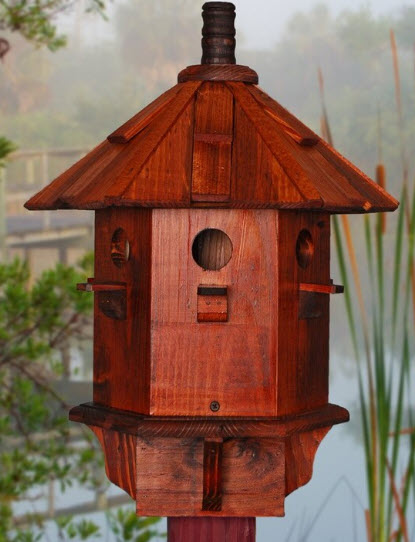 Yellow Finch Bird House Primitive
Yellow Finch Bird House Primitive
This birdhouse is designed for the yellow finch bird and can be a perfect addition to backyards with this type of bird.
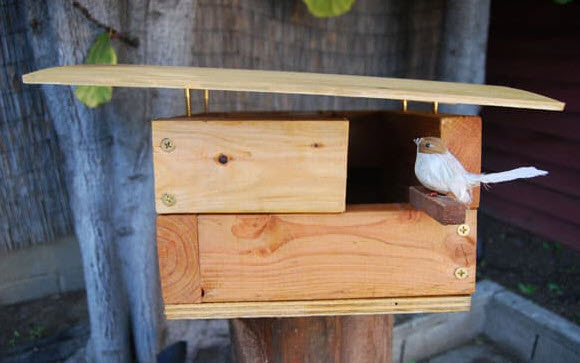 Modern Birdhouse Box
Modern Birdhouse Box
This is another modern addition to the list and it’s very easy to create with only minimal effort and materials required.
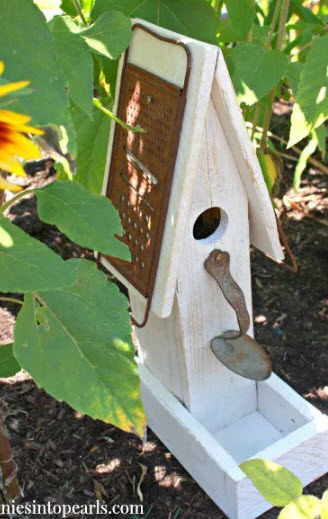 Scrap Wood DIY Bird house Plan
Scrap Wood DIY Bird house Plan
With this birdhouse design, you can create a habitat for the birds around your garden or backyard using scrap wood.
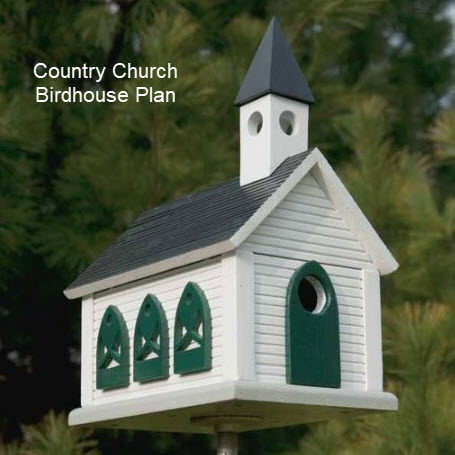 Country Church Birdhouse
Country Church Birdhouse
Like most DIY Bird house plans, this too is easy to build and features a country church design that’s appealing.
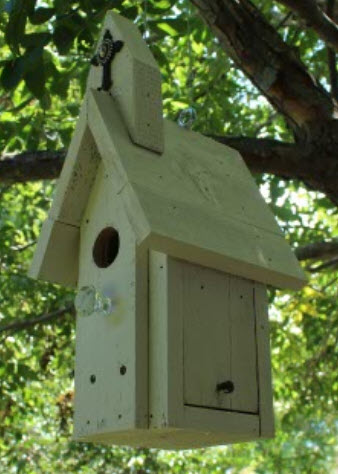 Church Bird house Plans
Church Bird house Plans
Finally, we have the church bird house plan that also features an outstanding look and can accommodate titmice, chickadee, finches, and wrens. Other small birds can also find this design suitable for nesting.
Finch House
How To Build A Finch Birdhouse

Here is the free finch birdhouse plan. Click Here
Build a finch birdhouse from cedar, pine or any soft wood.
Use rough-cut wood,
it gives better grip for birds to grab the nest box when they enter the house.
It is also easier for finch chicks to climb out the birdhouse later.
Let your imagination fly, you can build a finch birdhouse of any shape, but stick to these three dimensions.
The floor must be 6″ x 6″ (measured from the inside), the finch birdhouse hole size is 2″ and the height from the floor to the center of the hole is 4″.
Drill drain holes in the floor. Attach a hinged roof where you can easily monitor and clean the birdhouse. Use the hook to secure roof in closed position. Always use stainless steel screws.
Drill pilot holes as shown. This reduces the possibility of wood cracking, and the pilot hole simplifies assembly.
Some important finch birdhouse details
Proper ventilation is important. As you can see on the plan, there is a gap between the front panel and the roof to ensure air circulation. You can also drill some holes in the top edge of the side walls. Birdhouses should also have drainage holes to keep the birdhouse dry that prevent mold.
Wood is the best material to use when building a birdhouse, but make sure it is thicker than 0.75″. With thinner wood, the birdhouse can easily overheat.
Read more: What wood is best for birdhouses.
The finch birdhouse locatuin is also very important. Otherwise, they simply won’t use your birdhouse. Scroll down and read important facts about finches.
Click on the image to enlarge it.
If you want to know what’s going on in the nest box, use these cameras. It is a very relaxing sight.
Use this special camera to peek the finch birdhouse. See the hidden world.
Finch birdhouse installation instructions
Select a location that is sheltered from strong winds, direct sunlight, and predators such as cats and raccoons. Best and easyest way to install a finch birdhouse is to use a metal post. Screw metal post to the ground attach finch birdhouse and your done. Make sure that finch birdhouse is at least 5 feet of the ground.
The entrance hole should face away from prevailing winds and toward a safe and clear flight path. Make sure the birdhouse is not facing a busy area or a location where people or pets might disturb the birds.
Finch habits
Finches are migrating birds but only within their territory range but if there is a good supply of food and water they might stick around.
These birds are monogamous and the two birds bond even more during the winter. They travel and live together throughout their lives.
Finches do not like the idea of being caged. They love open free spaces to fly around. To keep one, make sure you give it the space it deserves. They also love to sing but in low tones.
They are social birds who travel and feed together and if you happen to spot one then there must be more around. Finches do not like the human touch and trying to hold one might frighten it off.
With the perfect finch house, you can attract as many finches as it can accommodate and you can continue enjoying having them around.
What attracts finch to the birdhouse
Setting up finch houses should never be rushed. Install the finch house in an open area so they can fly in any direction. The best time to do this is toward the end of summer and the beginning of fall.
Finches are attracted to small fresh dark seeds. Sunflower seeds and Nyjer seeds are some of their favorites and putting some out on their feeder each day, will see finches sweetening every day.
These birds love nesting and breeding near clean water sources. They also love taking birdbaths and adding sticks and stones helps show them that it’s shallow and encourages them to enter.
They are migrating birds and some might spot your house and take a birdbath relaxing from a long tiresome journey to its new home.
Just like most birds, finches are attracted to color. Tying bright-colored ribbons around and on the birdhouse will help attract as many more. Ribbons are also more attractive as they sway around in the wind and birds are more attracted to things that are not common.
Make sure to at least place the feeders at a high place and if you have trees around, you can use them to place the feeders. Finches like feeding on high places where they feel safe.
The finches enjoy the water. Having a water source near the birdhouse attracts finches to use the nest box or where they can refresh on a hot summer day.
Here Some Extreme birdhouses. Click The Picture.
Bluebird House Plans Sparrow Resistant
Easy way to Make Sparrow Resistant Bluebird House
Why and How to Do It
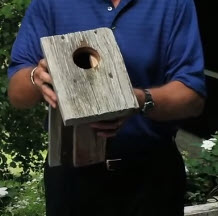
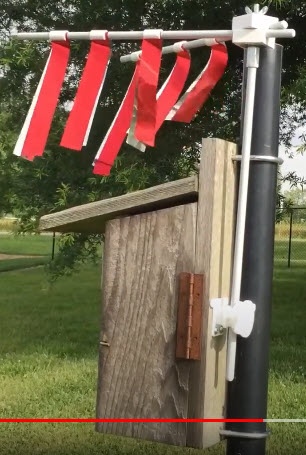
Bluebirds are some of the most popular backyard birds and with good reason too. After all, they are beautiful, friendly, insectivorous and songbirds.
Unfortunately, house sparrows are one of the biggest threats to successfully housing these blue beauties in the backyard. It is not uncommon for sparrows to populate birdhouses meant for bluebirds. We teach you how to make sparrow resistant bluebird house.
To nest bluebirds with ease, it is necessary to make their nest boxes resistant to house sparrows. Continue reading to understand how and why to make bluebird house sparrow resistant.
Related article:
Make these blue bird houses sparrow resistant.(PDF plans)
What is the best wood for building a birdhouse
How to keep sparrows out of bluebird houses
Add a skylight to the birdhouse
Research suggests that sparrows do not like it when sunlight gets into their nest boxes. Conversely, bluebirds do not seem to mind the extra light in their nests. Therefore, bird experts recommend adding skylights to bluebird houses in order to make bluebird house plans sparrow resistant.
A simple way to add a skylight is to drill a sizable hole into the top of a bluebird house, then cover it with plexiglass. The plexiglass helps to keep rain and the elements out.
Here is your Bluebird house plan PDF – Click Here to Download
Using Sparrow Spookers
Sparrow spookers refer to anything meant to scare away sparrows from perching on or entering a bluebird house. Using sparrow spookers on birdhouses is especially useful when a bluebird has already laid claim to a nesting box and has already laid an egg in the house.
It is possible to make a spooker using mono-filament fishing lines tied onto a ring and hang on top of the bird house. Ideally, the strings should swing around the entrance of the bluebird house. According to experts, sparrows hate flying through the lines and will therefore avoid houses that have them.
An alternative option is to hang several strips of a reflective material such as mylar film or even aluminum foil over the top of the bluebird house. When using this strategy, the strips ought to be long enough to brush against the roof of the house. Sparrows fear the strips and the sound they make while brushing over the box roof discourages them from taking up residence. However, since the strips may also scare away bluebirds, it is advisable to use this method only after a bluebird has claimed a box and laid its first eggs.
Build the birdhouse using PVC
It is not yet clear why, but research suggests that sparrows prefer wooden birdhouses to PVC birdhouses. In contrast, bluebirds do not mind nesting in PVC boxes.
Super Easy PVC bluebird house plans sparrow resistant by suncatcherstudio.com
Mounting a bluebird house, locate it an open location
House sparrows prefer nesting in locations that are close to buildings, houses and other forms of cover. For that reason, it is possible to keep sparrows away from a bluebird houses by putting it up in an open field, faraway from houses, buildings and human beings. Nonetheless, this option is not very feasible for bird enthusiasts who live in busy towns or cities.
The best blue bird house post. Good to use in open areas. Poke into the ground, secure the bluebird house and you’re done. Click the picture.
Some researchers also suggest that locating birdhouses close to the ground may also keep sparrows away as they prefer to nest higher up such as on roofs. Even then, this is not a very good strategy if the yard also has predators such as cats and raccoons.
Related article: Where to Place a Birdhouse
You will definitely find new and interesting birdhouse plans in these books.
PS: These designer birdhouses cost a lot!!! Good business opportunity. Look how much these designer birdhouse cost in an online store. These birdhouse plan books are a good investment
Why bluebirds need a sparrow resistant house
While all birds deserve protection, there are three primary reasons why bluebirds need extra protection from house sparrows:
- First, both groups of birds have a preference for nesting in natural as well as man-made cavities. However, sparrows fiercely out-compete bluebirds for nest boxes and will often evict them from their birdhouses. In short, when you put up a bird box in your yard, you are more than likely to attract house sparrows.
- House sparrows have a reputation for aggressiveness. In addition to forcefully evicting bluebirds from their houses, house sparrows also break their eggs and may even kill young and adult bluebirds.
- While bluebirds are North American natives, house sparrows are invasive and alien to the continent. In fact, house sparrows have only been in North American for about 169 years. Since bluebirds are native, they are protected under American law. Therefore, it is completely legal to remove sparrows or discriminate against sparrows from backyard nests with the intention of protecting Sialia.
The aggressive and over-competitive nature of house sparrows also means that bluebirds cannot comfortably nest close to a sparrow nest. Apart from dominating the competition for shelter, sparrows would also dominate the competition for food.
Parting Shot
According to conservationists, the population of bluebirds reduced drastically in the 20th century. So much that there were fears the bird would go extinct. Although the population of these North American native birds is on the rise again, more efforts are required to ensure that bluebirds thrive again.
Making bluebird house sparrow resistant is one way of contributing to the protection and conservation of these lovable and gentle birds.
Purple martin house plans
Purple Martin House Plans
Article includes purple martin house plans, installation recommendations and nesting habits.
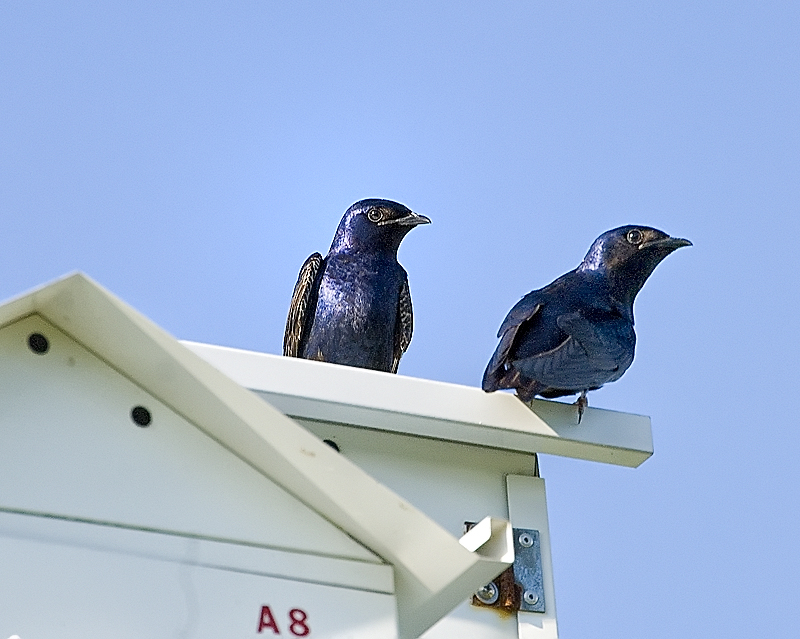

Purple martins are excellent insect control agents, making them a valuable addition to any backyard. Building a purple martin house plans are a fun and rewarding projects that will not only provide a home for these lovely birds, but also add beauty and charm to your backyard. In this article, we will show you purple martin house plans and guide you through the process of building a purple martin house, including materials, design, and placement.
4 purple martin house plans
We have four different purple martin house plans for you. All four different purple martin house plans are in pdf format. Save them to your computer or print them out.
The first is a gable roof purple martin house with 12 apartments.
Your free Purple Martin house plan PDF Click Here To Download It
The second martin house has 16 apartments and also has a gable roof.
The third birdhouse may be a bit difficult to build for someone, but it’s beautiful. Here are two pdf files. Both have the same birdhouse, but one has 4 apartments and the other has 8 apartments.
Download balga canadian doublet-503
Download balga single taverner-502
The last purple martin house solution is the easiest in my opinion. It is made of inch-thick Styrofoam.
After downloading, be sure to read the correct installation recommendations that are written below. Other tricks to get purple martins to use your birdhouse in the future.
You can start with small Purple martin house…
The martins live in clustered housing. They stay in colonies of 2 to 200 pairs. Single structures arranged in a cluster of many compartments with multiple entrances are popular. They provide appropriate housing for many purple martins. Three to four units are ideal housing for a start. You can add more as the colony expands.
Like this purple martin house.
At the beginning you can set up a four-room birdhouse. As the colony grows, you can easily add rooms. This purple martin house allows you to add 4 floors with a total of 16 rooms.
As soon as you notice martins existing within your area, you should install some Purple Martin house to get the first pair in houses. Once the first pair accepts your housing, you can be sure you will have a whole colony after some time.
Purple martin gourds
Another type of birdhouse that martins prefer is purple martin gourds. Hollowed-out gourds have been used for centuries to attract purple martins. Here is good blog post: DIY Gourd Birdhouse.
You do not have to hollow gourds yourself. You can use plastic purple martin gourds but the gourd size need to be 8 to 13 inches(200 to 330mm) in diameter. Do not paint the interior of the gourd. The entrance needs to be the same size as traditional purple martin house 2 1/8 inches(54mm) . The purple martin gourds outside part should be painted white and come with baffles and guards to protect the birds from predators. Use purple martin gourd rack where they are protected and have nice housing complex.

Purple martins love white houses. White is a color that reflects heat, in turn making the house cooler. It is also easy for the birds to spot a white chamber with a dark entrance hole. Many manufacturers provide plastic purple martin gourds birdhouses. However, natural dried and treated gourds are also appropriate.
Best plastic purple martin gourds
Great DIY birdhouse books where you can find new birdhouse ideas and designs
Purple Martin House Dimensions
The dimensions are important factors in determining if the martins will accept the birdhouse. A too small house may make it hard for the birds to enter or exit, and growing nestlings may get injured in the inadequate space. On the other hand, a house that is too large will make it easy for predators to kill nesting birds, and other larger birds may nest in the home. The size of the entrance hole should be between 1 3/4(45mm) and 2 1/4 inches(57mm). 2 1/8 inches(54mm) is the most popular purple martin birdhouse entrance hole size. The entrance hole height should be above the floor by 1 inch (25mm).
Related article: Birdhouse entrance hole size and other important dimensions
The interior floor area should have a minimum space of 6 by 6 inches(150x150mm). However, slightly larger birdhouses are appropriate for large broods. The interior height should be between 5 to 7 inches(120x170mm) for adequate space and ventilation. But for purple martins gourds, the height can be 8 inches(200mm) to accommodate the unusual shape. Porches are not a must for purple martin houses, but you can use them. They should be 4 inches (100mm) wide to leave enough room for the birds to walk safely.
Purple martin house location
Mount purple martin birdhouse on a post or pole and purple martin house height of the ground should be 12 to 20 feet (3 to 6m) high. The martin birdhouse should not be attached to a tree because predators like raccoons and cats could easily access the nest. These types of birds need a large open area to feed. It is appropriate to place the house at the center of the open space 30 feet (9m) away from structures and trees. Purple martins aren’t too picky about direction of the birdhouse, then it doesn’t matter what direction should a purple martin house face.
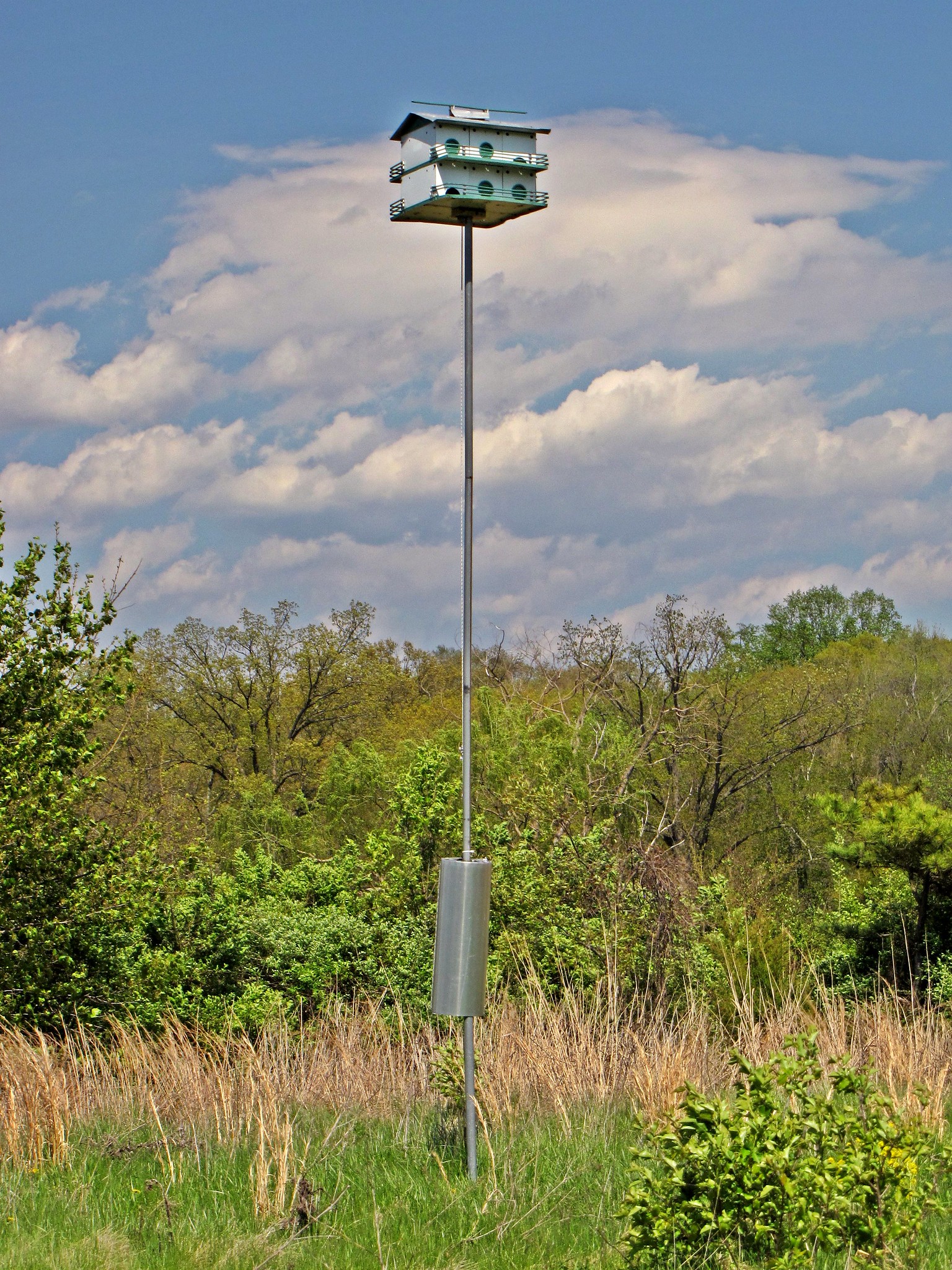
Ideally, there should be no taller trees within 60 feet (18m) of the birdhouse. Purple martin house should be close to your home. When these birds see human activity, they know they are protected against predators. The birds also prefer their nest to be half a mile away from a water source like a lake.
The purple martin bird house complex can be very heavy, with a winch it is very easy to install a bird house. If you want to clean the birdhouse use a winch to take the birdhouse down.
Related article: Where to Place a Birdhouse
Why use a pole to install a Purple Martin house
Purple martin house location is essential. It is vital to use a purple martin house pole to install it for added stability. A purple martin pole system helps the birds to avoid maneuvering through trees or dodging telephone wires. The birds should be able to see the opening of their homes without stopping. A well-designed purple martin house plans should be raised and lowered vertically during an inspection.
Most systems use a winch because the houses can be heavy, especially when they are full of eggs or babies. It is essential to check the nestling, clean the house, and evict unwelcome visitors such as sparrows, hawks, and owls.
Which posts are available and which are the best
The pole is essential to support the birdhouse so you shouldn’t forget to make one on your own. Wooden posts and tree limbs are some of the most preferred materials to use when creating a pole by yourself.
There is also the option to buy those available in the market today. Most are made of durable materials and manufactured with metal. They also come with different hanging stations. All you have to do is check online at the various purple martin pole system options and choose one that fits your needs best.
It is best to choose purple martin house pole manufactured by reputable companies, especially if you do not know how to make one by yourself. The purple martin house pole will come with the correct dimensions making it easy to install.
Conclusion
As a purple martin landlord, the materials and construction methods used should withstand hail storms and wind. You should be the house that will last with easy maintenance. Treatments are necessary for both the pole and house to help reduce the effects of rusting and weathering. Telescoping and winch systems need to be wealthy regularly. Also, you should check the cables and ropes for signs of wear. Building houses that are safe and effective for purple martin colonies help reduce the risk of unwanted tenants.
You definitely know these annoying gadflies(horse-fly). The best control against them is purple martin, because they love to eat them. Install a purple martini house in your backyard, they will take care of the gadflies(horse-fly) and you can calmly enjoy the sun and birds.
Related posts:
What do birds eat – some seeds can be dangerous, find out what is the right food for birds.
Bluebird house – Everything you need to know about bluebird houses
Birdhouse Hole Sizes – drill the right size entry holes for birdhouses, birdhouse hole size chart
cookie
Bluebird house plans
Download Your BlueBird House Plans.
Five free
Eastern, Western & Mountain
Blue Bird House Plans PDF
Find out why building a bluebird house is extremely important.

In this guide, we will explore the bluebird houses and their role in boosting the bluebird population. We’ll also give you bluebird house plans PDF. Plus, we’ll provide insights into the dimensions and features that make a bluebird house a safe for these birds.
If building a bluebird house seems difficult to you, you can also find ready-made bluebird houses here. Just scroll down. Enjoy reading!
Take Your Birdhouse Building Skills To The Next Level
This book is the Birdhouse builders bible. Includes several bird species birdhouse plans and feeders, plus some interesting bonuses.
Here is bluebird house plans PDF
The United States Department of Agriculture (USDA)
Xbox bluebird nest box plan PDF by nestboxbuilder.com
F30 bluebird nestbox PDF – Ideal for Western/Mountain Bluebirds by nestboxbuilder.com
Gilbertson bluebird house (pvc bluebird house plans) by nestboxbuilder.com
Dimensions For a Bluebird house plans
What dimensions should a bluebird house have?
To ensure your bluebird house meets the highest standards, it’s essential to get the dimensions right. Here’s what you need to consider:
- Interior Space: When crafting a bluebird house, focus on comfort. The ideal house should have an interior floor space of 5×5 inches, providing ample room for up to eight chicks while optimizing space.
- Entrance Hole: The entrance hole is a critical aspect. For Eastern and Western bluebirds, aim for a 1 ½-inch (3.8 centimeters) diameter, while Mountain bluebird houses should have an entrance with a diameter of 1 9/16 inches (4.0 centimeters). Prevent the hole from enlarging over time by using entry hole protectors, which also act as a barrier against predators.
- Entrance Height: Position the entrance hole 6 to 10 inches (15-25 centimeters) above the base. This height ensures hatchlings don’t tumble out and keeps predators at bay. Adding mesh or rough scoring inside the house facilitates easy access for the birds.
- The Bluebird House Height: Option for a house that stands between 8 to 12 inches, with a slightly taller rear section to offer shelter and shade at the entrance. While there are various design options, consider the practicality of the design for young birds leaving the nest, balancing safety and accessibility.
Protect your bluebirds. Making Bluebird house house Sparrow Resistant
Educational video about bluebird house plans
Bluebird Houses For Sale
Best bluebird house.
iej
More bluebird house kits find here
Where is the best place to install a bluebird house and when?
Even a bluebird house might not make any impact if it is wrongly positioned, so make sure to place birdhouses in a place where they naturally attract the bluebirds.
Making your bluebird house safe involves considering multiple factors:
– Sparrow Resistance: Preventing invasive birds like sparrows from taking over is crucial. Ensure your bluebird house design minimizes the risk of unwanted residents.
3 tricks to make the bluebird’s house sparrow resistance. Click here
The success of a bluebird house depends on proper placement:
– Location Matters: Bluebirds thrive in open areas, so mount the house in spots with ample open space for foraging. Install nest boxes 4 to 6 feet above the ground, and if you’re setting up multiple houses, space them about 92 meters (100 yards) apart to ensure the birds feel secure.
– Direction Counts: Ideally, orient the bluebird house south or southeast, facing open areas. Within 25-100 feet of the house, provide a tree, shrub, or fence. This helps young birds on their first flights, enhancing their chances of survival.
– Timing Is Everything: While bluebirds roost in birdhouses during the winter, early spring, around February, is the best time to install a bluebird house. After installation, regular maintenance is essential to keep the house in top condition.
– Regular Maintenance: Cleaning bluebird houses after each breeding season is crucial to minimize hazards like rodents, insects, mites, bacteria, and fungus. A well-maintained bluebird house ensures the safety and well-being of your avian residents.
Best Bluebird house poles
kk
Benefits of bluebird house in the garden
Bluebirds are incredibly beneficial, and many gardeners like them because they are voracious insect eaters. Their bug-eating habits make them great assets in helping reduce pests.
They also exhibit fascinating colors and behavior patterns that any birdwatcher will enjoy.
Conclusion
Bluebirds are more than just charming visitors. They are voracious insect eaters, making them valuable assets in pest control. Their vibrant colors and captivating behavior patterns also make them a delight for birdwatchers.
Becoming a bluebird landlord is a fulfilling experience, and your efforts can significantly impact the bluebird population. Whether they choose your house as their nesting spot or not, bluebirds tend to return year after year, and it’s a joy to host them.
Don’t forget to share your newfound knowledge about bluebirds and this guide with friends, family, or fellow bird enthusiasts. Explore additional resources to delve deeper into the world of bluebirds. By making your bluebird house a welcoming haven, you contribute to the preservation of these magnificent birds and create a harmonious space in your backyard.
It is always interesting to read about blue birds and share this knowledge with your children or friends. Here are the best bluebird books.
What do birds eat
Know what do birds eat and offer them the right food
What Do Backyard Birds Eat

Enjoying nature is one of the most peaceful things you can indulge in. Whether you live upcountry or in the city, it is easy to attract birds of various species to your porch or balcony. All you need is to either build a feeder or buy one. These are easy to set up and as long as it has some bird feed in it, then you will enjoy watching various species of birds come and go from the feeder.
It is not clear whether bird feeders contribute to the overall protection and bird population in the world. But feeders in your back yard can help the birds in your neighborhood. The general rule concerning the feeding of wild animals is, do not do it if you run the risk of harm. Birds are considered harmless so, by all means, go right ahead and feed them
There are numerous species of birds around the world. This means there are also numerous types of feeds for birds depending on the bird species. The season of the year may also determine what birds eat. Birds may eat different seeds and fruits in the winter as compared to the summer.
Below we look at various Bird feeds depending on species, season, etc.
The bird feeds in the summer and winter seasons
You may have noticed that birds flock to your feeder in the summer. But you struggle to attract birds in the winter or vice versa. What you feed your birds determines the number and species of birds that you can attract to your feeder. Of importance to note is that the same bird can feed on different things depending on the season. This means a bird can be at your feeder in the summer but not come to it in the winter, as it seeks food that will enable it to hibernate.
Below are some foods you can feed in the winter.
Shelled Peanuts- This means peanuts without a shell. Unsalted and dry roasted peanuts provide the much-needed fat and protein for birds that are necessary to provide energy and warmth in the winter.
Safflower- It is a shelled, white, conical seed eaten by birds especially the northern cardinal. Some bird experts claim that safflower seeds are not easily eaten by squirrels. Nevertheless, safflower should not be placed on the ground since it easily absorbs water and can be soggy and inedible in the winter.
Fruit- Humans are encouraged to eat at least three fruits a day. The benefits that humans get from fruits is similar to that of birds. If you can afford, you can set out on the feeder banana slices, apples, grapes, and citrus fruits, etc.
Other foods that can be feed to birds in the summer include mealworms, cracked corn, nyjer, suet, and black-oiled sunflower seeds.
In the summer, birds require high protein foods especially when they are molting. In the summer, it advisable to feed birds with natural food as possible. Earthworms and caterpillars. In the absence of this, you can feed them mealworms and buggy nibbles.
Other foods you can feed them include black sunflower seeds, soaked sultanas, pinhead oatmeal, etc.
Some people use soaked dog and cat food. The risk with this is that your cats may just feed on them from the bird feeder.
Wild feeds.
Birds would prefer feeding on bird feeders. But what do they eat in the wild? This depends on the bird species.
Robins and blackbirds eat spiders, earthworms, and snails. House sparrows will feed on natural seeds from plants such as Dock. During the summer, they may hunt for caterpillars and aphids.
Most birds normally feed on natural seeds from wild plants and invertebrates and insects such as caterpillars and spiders.
Seeds for Bird feeders.
There are numerous types of bird feed mixes. The cheaper mixes mostly contain millet and small amounts of cracked corn and other seeds of grains. However, a lot of it can go to waste as most birds will seek out the favorite seeds in the mix and leave the rest. Wheat is a popular addition but has little nutritional value.
The best seeds for bird feeders are dried mealworms, pumpkin seeds, sunflower seeds, nyjer, dried fruit, and nuts.
Dangerous seeds for Bird feeders
You may mistakenly assume that bird seeds are obvious and easy to identify. However, some seeds can be dangerous to your birds and you may end up doing more harm than good in feeding birds from a bird feeder.
Chocolate can be eaten by humans but the digestive system of birds cannot handle chocolate. It can cause vomiting and diarrhea to birds. Seeds that can harm a bird include apple seeds, dried beans, and Avocado seeds. Other dangerous things to feed your pet include, mushrooms. Caffeine, alcohol, and salt.
Below we look at what some specific bird species eat.
 Bluebird- These birds feed on sunflower bits, fruits, and mealworms
Bluebird- These birds feed on sunflower bits, fruits, and mealworms
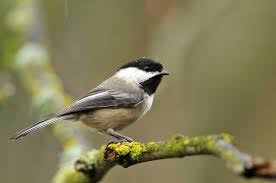 Chickadee- These birds enjoy peanut butter and suet at bird feeders. Other feeds they eat include insects, berries, seeds, and portions of carrion.
Chickadee- These birds enjoy peanut butter and suet at bird feeders. Other feeds they eat include insects, berries, seeds, and portions of carrion.
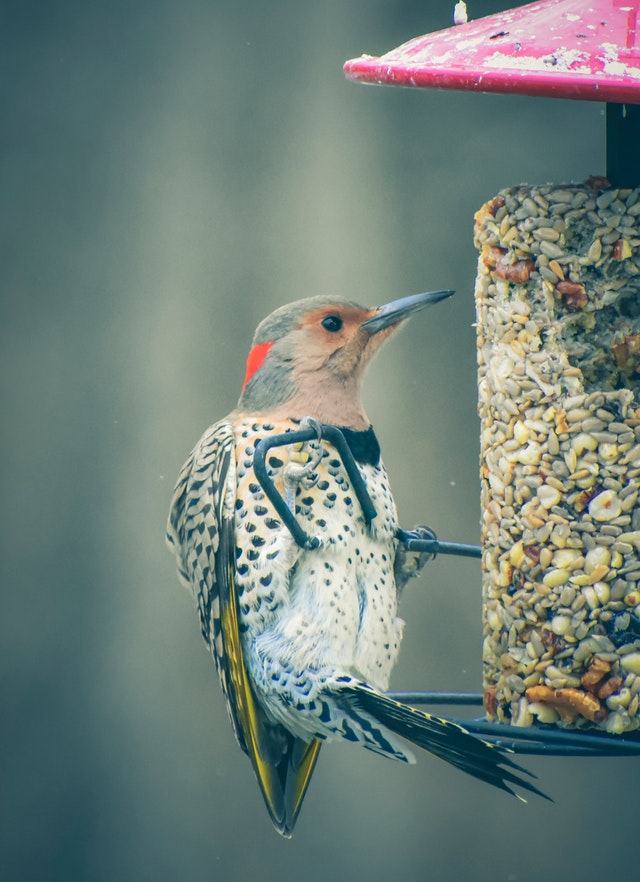 Flicker-The hunt for ants and larvae underground. They also feed on insects such as beetles. In the winter, they can feed on seeds and fruits
Flicker-The hunt for ants and larvae underground. They also feed on insects such as beetles. In the winter, they can feed on seeds and fruits
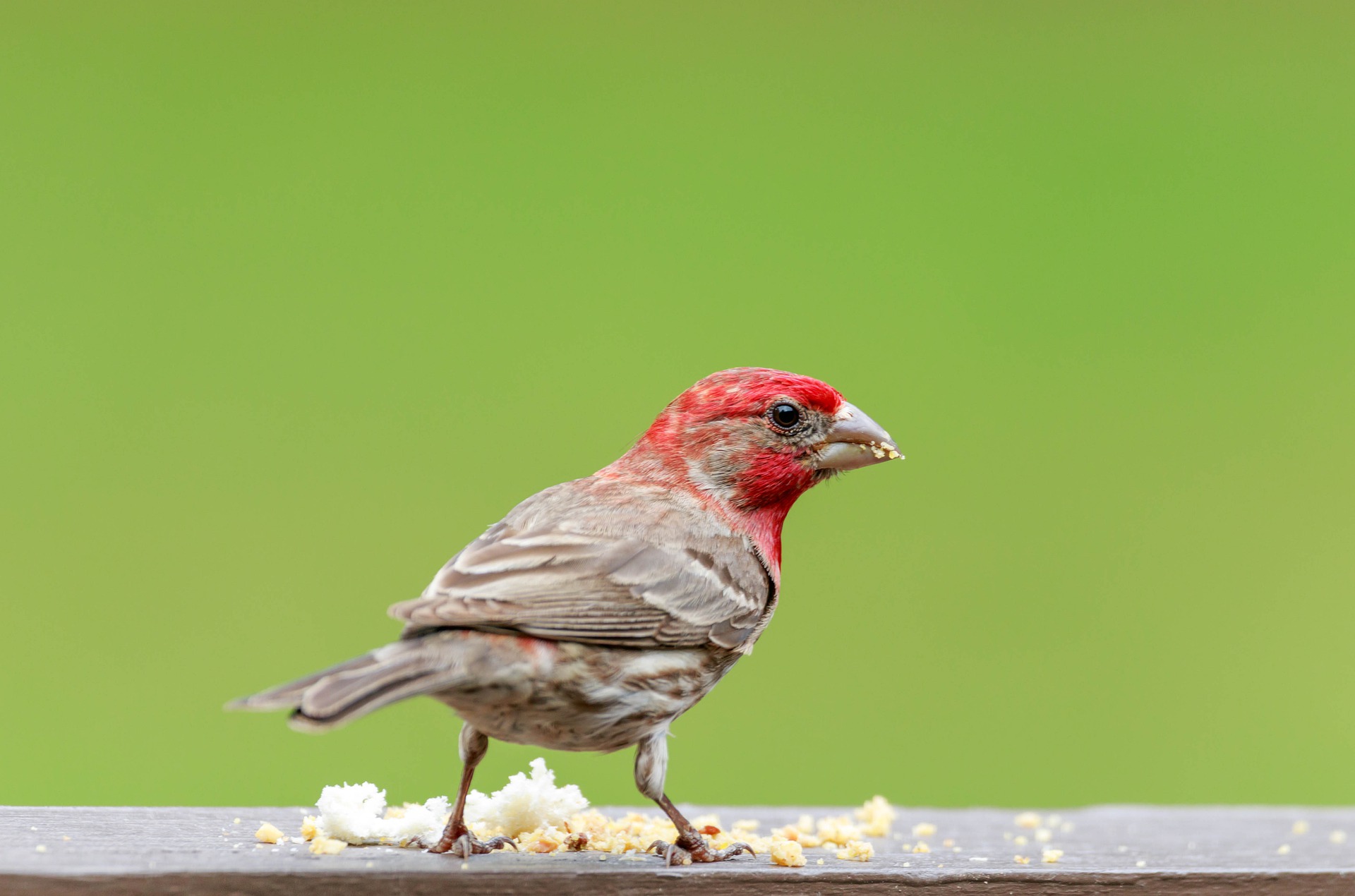 House Finch- These birds feed exclusively on plant material such as seeds, fruits, and buds. In the wild, they feed on mustard seeds, mulberry, thistle, knotweed among others.
House Finch- These birds feed exclusively on plant material such as seeds, fruits, and buds. In the wild, they feed on mustard seeds, mulberry, thistle, knotweed among others.
 House Sparrow- These birds normally feed on grains and seeds. Sometimes they can feed on livestock feed and our discarded food. They eat crops such as sorghum and wheat. In the wild, they eat crabgrass and ragweed among others. They also enjoy sunflower seeds
House Sparrow- These birds normally feed on grains and seeds. Sometimes they can feed on livestock feed and our discarded food. They eat crops such as sorghum and wheat. In the wild, they eat crabgrass and ragweed among others. They also enjoy sunflower seeds
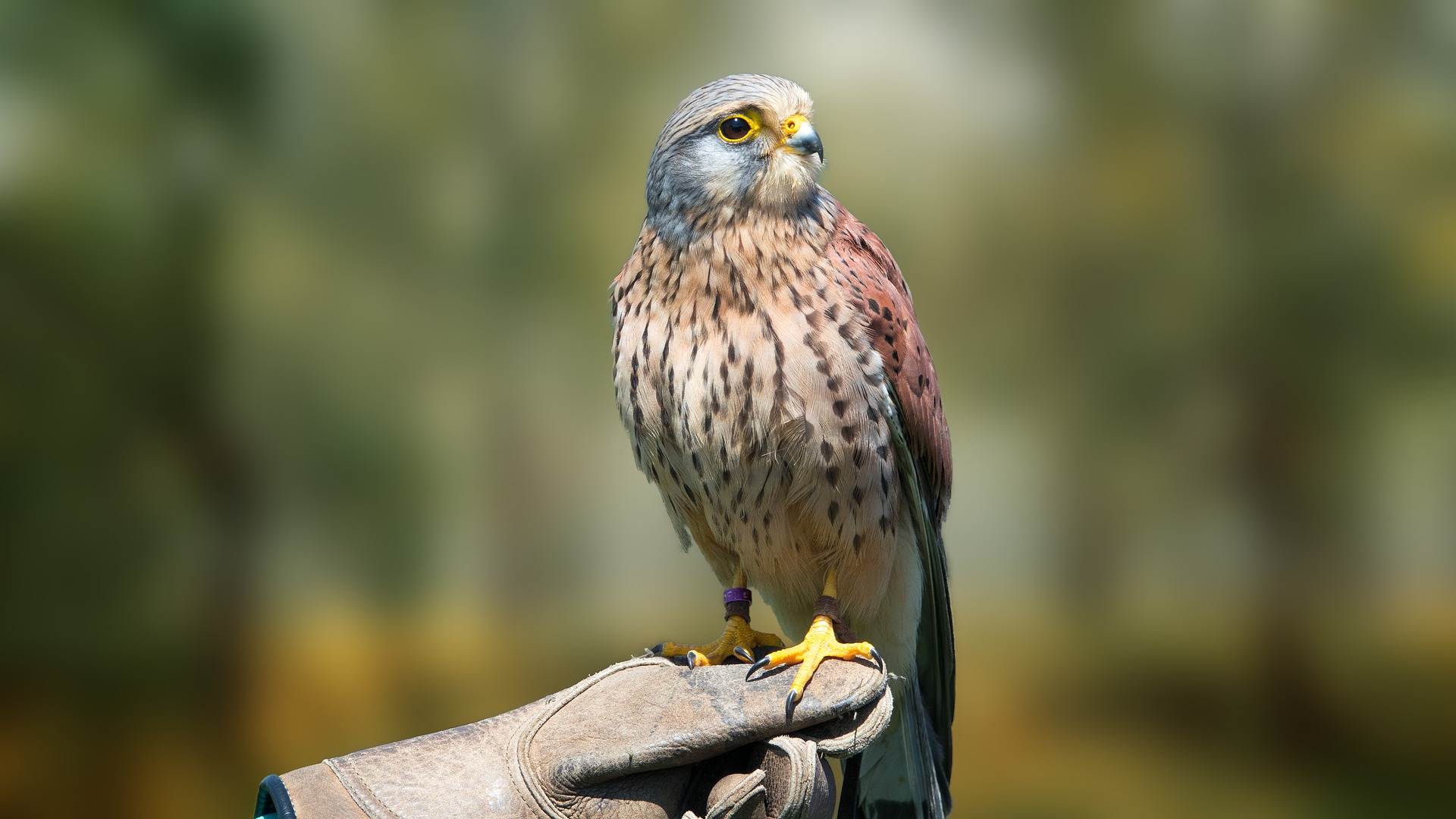 Kestrel- They feed on small agile prey such as insects, beetles, earthworms, and wood mice. They can also feed on small birds
Kestrel- They feed on small agile prey such as insects, beetles, earthworms, and wood mice. They can also feed on small birds
 Nuthatches- They uniquely feed while upside down mainly on tree barks. However, they will visit your feeder to eat some sunflower seeds, peanut butter, mealworms, and suet among others.
Nuthatches- They uniquely feed while upside down mainly on tree barks. However, they will visit your feeder to eat some sunflower seeds, peanut butter, mealworms, and suet among others.
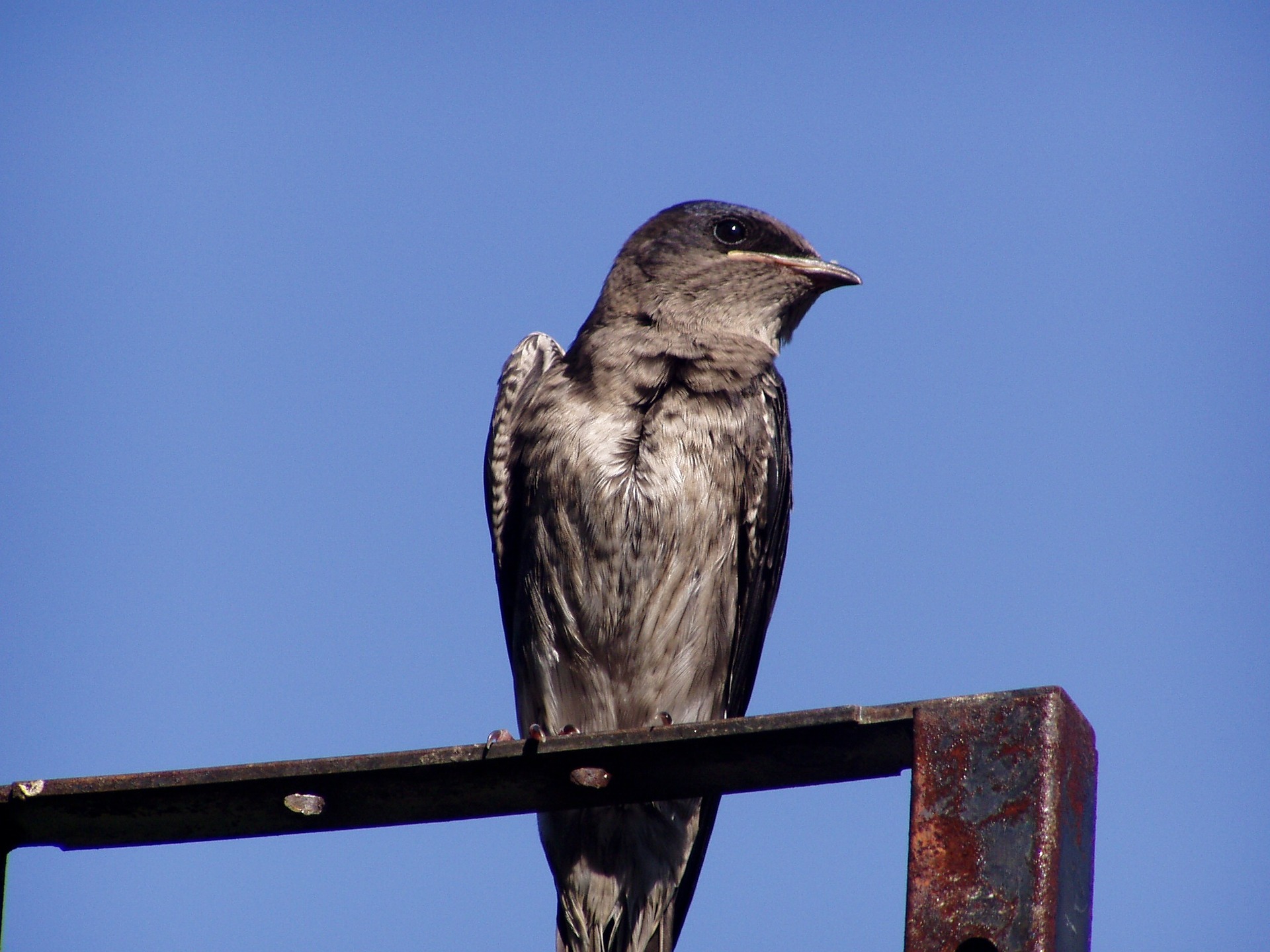 Purple Martin- Feeds mostly on flying insects such as wasps, houseflies, and crane flies. They also feed on moths, butterflies, and dragonflies. They can also feed on some spiders.
Purple Martin- Feeds mostly on flying insects such as wasps, houseflies, and crane flies. They also feed on moths, butterflies, and dragonflies. They can also feed on some spiders.
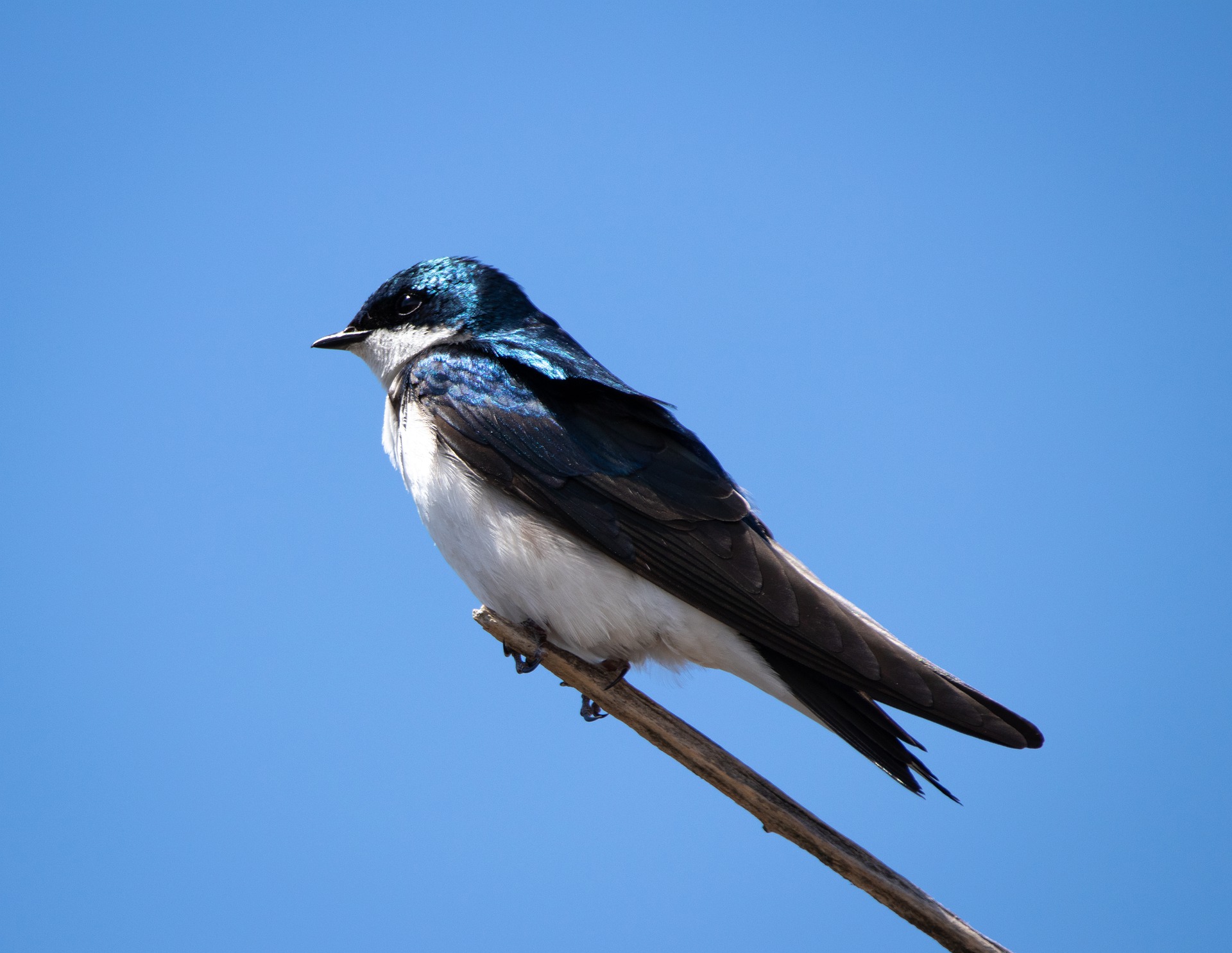 Tree Swallow- These birds feed mainly on insects such as sand fleas, spiders, and beetles.
Tree Swallow- These birds feed mainly on insects such as sand fleas, spiders, and beetles.
 Warbler- These will mostly eat insects and spiders. However, in the winter it is common to see them feeding on seeds and berries. They also enjoy suet.
Warbler- These will mostly eat insects and spiders. However, in the winter it is common to see them feeding on seeds and berries. They also enjoy suet.
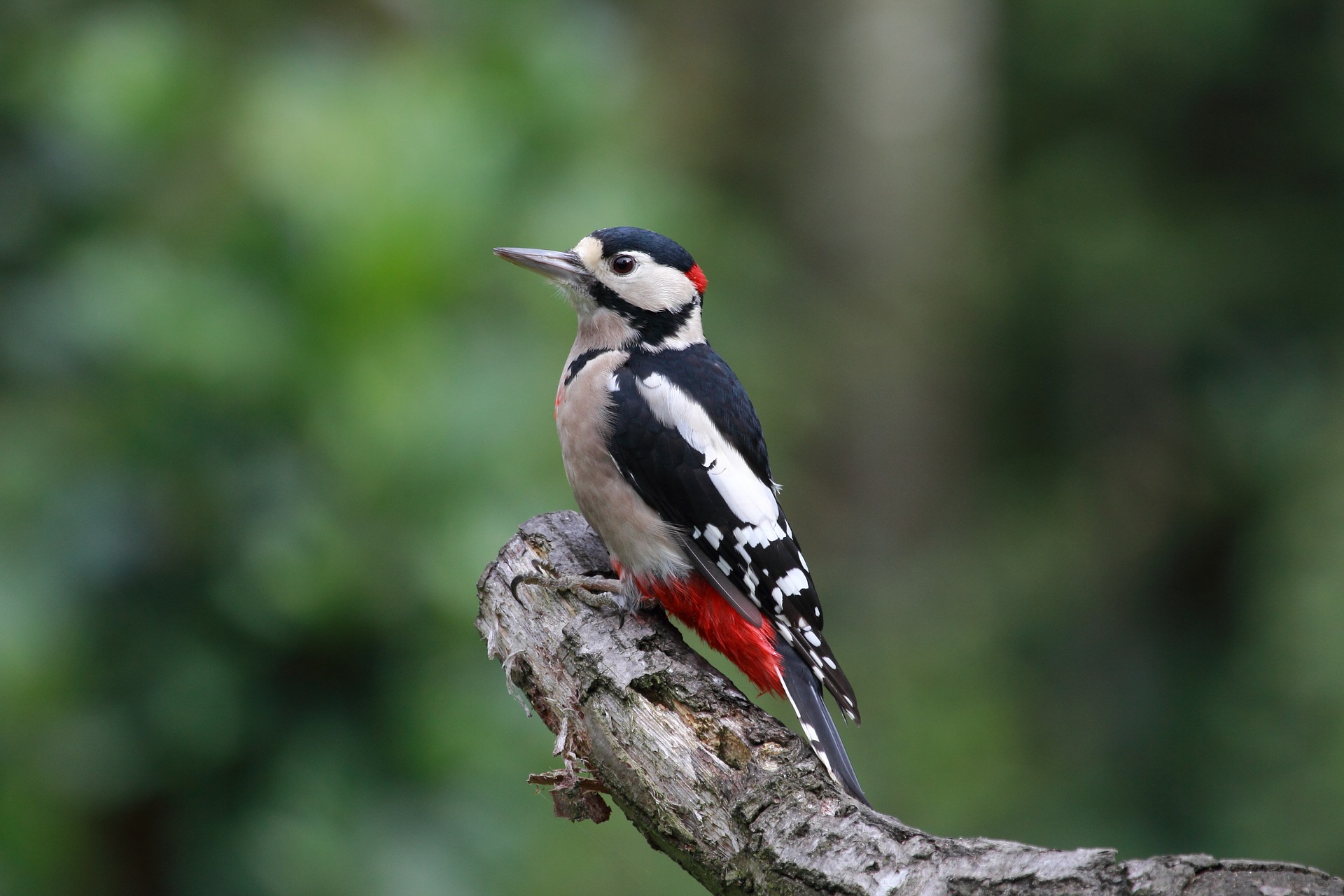 Woodpecker-The most common foods include insects such as ants and grabs and wood-boring insects.
Woodpecker-The most common foods include insects such as ants and grabs and wood-boring insects.
 Wren- These birds consume insects, spiders, bugs, and beetles. The younger ones can be fed grasshoppers and caterpillars.
Wren- These birds consume insects, spiders, bugs, and beetles. The younger ones can be fed grasshoppers and caterpillars.
DIY birdhouse kit
DIY Birdhouse Kit
Check out this awesome Woodworking Book. Includes cool birdhouse kits and plans.
My first birdhouse for chickadees.
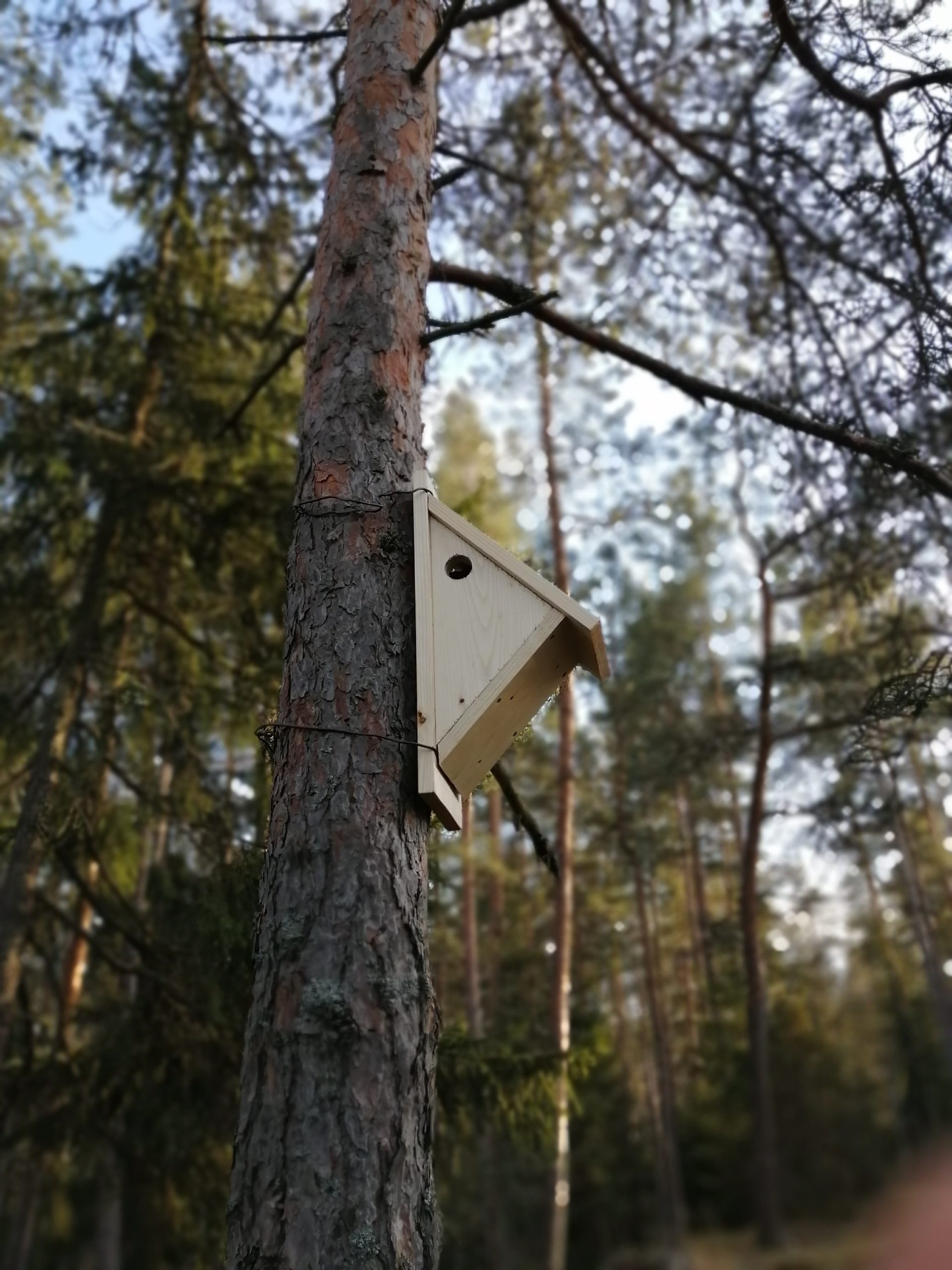
Related posts:
Chickadees Birdhouse Plans And Nesting Habits
DIY Birdhouse plan for variety bird species
What Size Entrance Hole For Birdhouse Should I Drill
Build Your Birdhouse With The Right Woodworking Tools Big Sale
12
Big List Birdhouse Plans For Different Bird Species
Where to Place a Birdhouse
Where To Place A Birdhouse
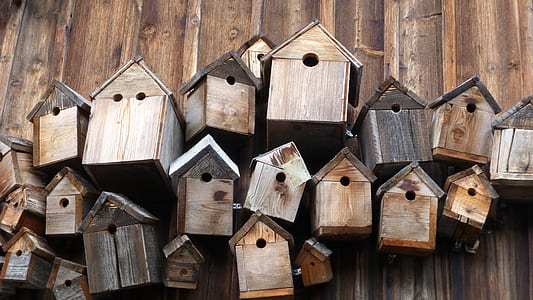
Where to place a birdhouse? This is a good and important question, because hanging the birdhouse in what you think is a good place may not actually be suitable for birds. We will give you instructions on how to start when hanging a birdhouse. In addition, we will point out separately where to install birdhouses for well-known bird species.
Four main points, Where to place a birdhouse
If you have a question of where to place a birdhouse, you probably have a birdhouse. There are four main points to keep in mind when placing a birdhouse.
First, look at your birdhouse and measure the entrance hole size. It depends on which bird species can fit there. If you know which bird species it is suitable for, then the location of the birdhouse must be chosen according to the bird species.
Here is birdhouse entrance hole sizes chart.
Second is the height of the birdhouse from the ground. Each bird species has its own nesting height where it is comfortable and safe for them to raise their young.
Third, it’s important to make sure that the birdhouse is secure and stable. The birdhouse should be attached to a sturdy post or tree trunk, and it should not wobble or sway in the wind. Most birds do not like swaying birdhouses. If you hang the birdhouse on a tree branch, probably no one will use it because it will sway in the wind. The only bird that can use it is the wren.
Fourth, the bird house should be placed in a place that is not easily accessible to predators. It should also be placed in a location protected from harsh weather such as strong winds or direct rain. Birds want peace during nesting, place the birdhouse at least 50ft (15m) away from the bird feeder.
Place a birdhouse by bird species.
Below we have a long list of bird species and where to place their birdhouses.
Where to place bluebird houses
If you think where to hang bluebird house then the answer is do not hang bluebird house. Bluebirds like a birdhouse that stays firmly in place. For this, you can use a metal post (which you can get here) or you can place the bluebird house on the fence or on the house wall. Place bluebird house around 4 to 6 feet above the ground, facing east or north an open fields or meadows, away from heavily wooded areas. The bluebird likes to nest low, so be sure to use a predator guard.
Here is a good bluebird house predator guard overview.
Where to place a chickadee birdhouse
Chickadees prefer to nest in wooded areas, near the edge of the forest. If you have a tree or bush in your yard/garden, then this place is right for a chickadee birdhouse. Chickadees like when the nesting place is hidden. Don’t worry, they will find your birdhouse 🙂 Place a birdhouse 5 to 15 feet above the ground, facing east or southeast.
Purple martin house placement
Purple Martins are social birds and prefer to nest in large colonies. A good location for a Purple Martin house is in an open area, at least 30 feet away from trees and other structures. The house should be 10 to 15 feet above the ground and should have multiple compartments.
Here is purple martin house plans and installing equipments
Where to place a wren house
Wrens are social birds. They not afraid to nest near people. You can even install the wren birdhouse on the terrace where you can watch them up close. But in general wrens prefer to nest in areas with dense vegetation such as shrubs, bushes or trees. Mount the birdhouse on a post, wall or hang it on a hook but make sure that it is 6 to 10 feet off the ground, facing east or southeast.
Sparrow birdhouse placements
Mount sparrow birdhouse on a pole, building fasade or fence near some trees or bushes and hight should be 6 to 10 feet above the ground. Make sure the entrance hole faces away from prevailing winds and towards a nearby tree or shrub.
Mount birdhouse for kestrel
Kestrels like wide-open area such as a field or pasture. Mount birdhouse for kestrel on post or tree trunk 10 to 20 feet above the ground and face entrance hole towards a nearby tree or pole.
Mount birdhouse for nuthatch
Nuthatch likes if their nesting place is hidden. That’s why mount the birdhouse on a tree or a post in a wooded area and 6 to 10 feet above the ground.
Where to put a robin nest box
Robin birdhouses should be placed in a fairly open area. They prefer areas with scattered trees, open woodlands and also parks, gardens and backyards. Mount robin nest box on a building facade or on a metal post at least 6 to 15 feet above the ground. Robin doesn’t like noise avoid areas with heavy foot traffic.
How Far Apart Should Birdhouses Be Placed?
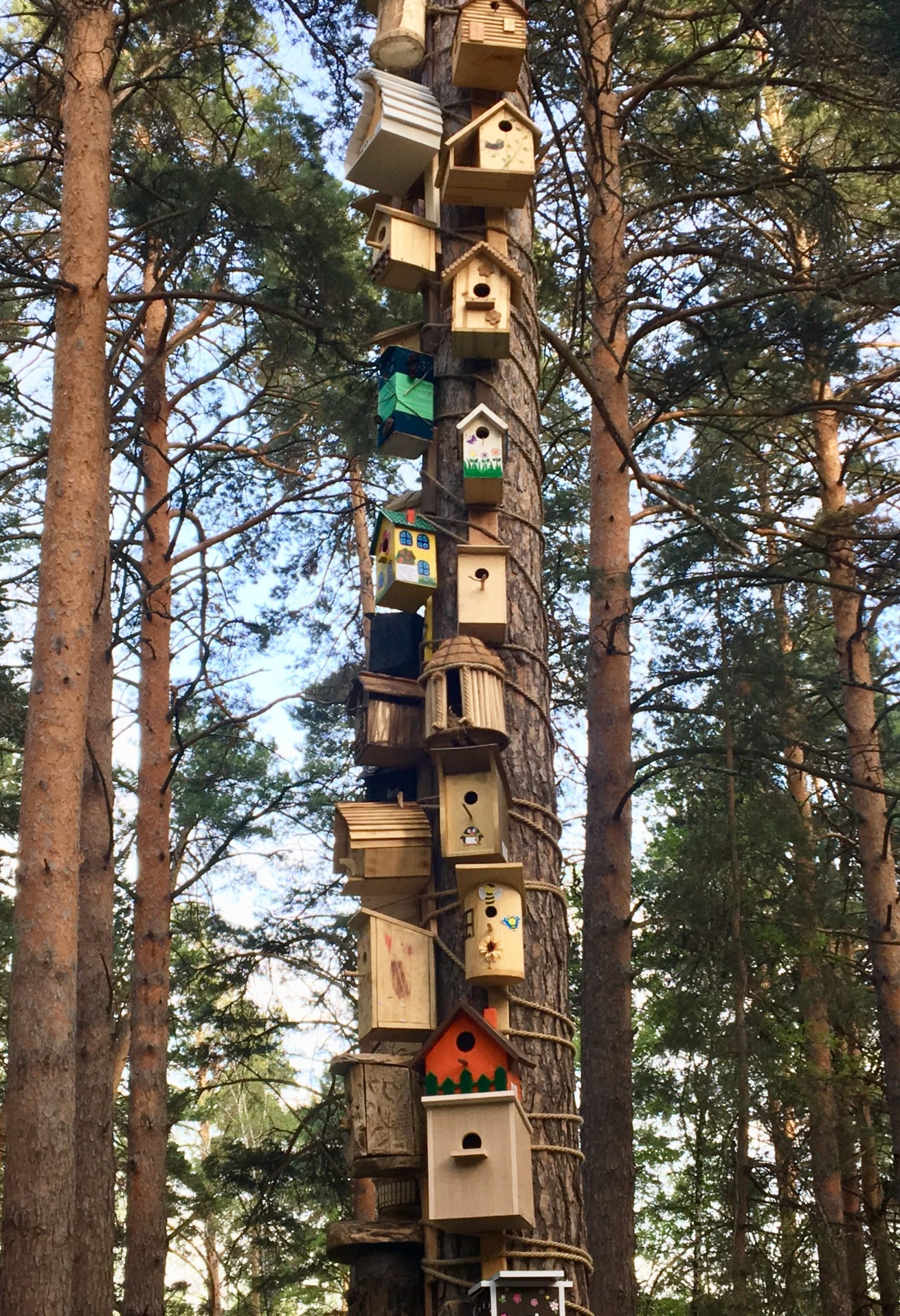 Again, the answer depends on what species you’re trying to attract to your garden. Some species don’t mind sheltering in close proximity to other birds. Many are naturally territorial and won’t use a birdhouse if it’s too close to other nesting spots.
Again, the answer depends on what species you’re trying to attract to your garden. Some species don’t mind sheltering in close proximity to other birds. Many are naturally territorial and won’t use a birdhouse if it’s too close to other nesting spots.
Some bird species like wrens will actively fill all of the birdhouses in a particular location – often with bits of garden debris – to render them unusable for other visitors. If this happens, you’ll need to empty these ‘fake’ nests to make room for other birds.
Our advice is to place birdhouses around five meters apart to allow for maximum usage. There’s nothing to stop you placing many birdboxes around your garden. However, our recommendation is to stop at two or three boxes if you want to give visiting birds the best shelter possible.
What Direction Should a Birdhouse Face?
Now, this is a question with a firm answer at last. The optimum direction for a birdhouse to face is the east. Birdhouses facing east get the best of everything. They benefit from the warmth of the early morning sunshine. Plus, they don’t overheat as the sun rises and sets in the afternoon.
Birdhouses facing in different directions will attract some visitors. However, the lack of protection from the elements will be an issue for others. Some other tips include facing the birdhouse away from strong winds. You should also ensure that it’s not too close to bird feeders and bird tables, particularly if they are frequented by cats and other local critters.
Best place to put a birdhouse


